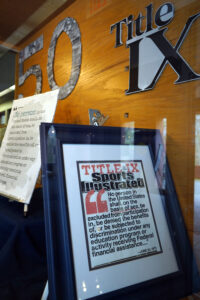
The University of Mary Washington is showcasing a half-century of Title IX history this April in recognition of Sexual Assault Awareness Month.
Offices across campus came together to create two Simpson Library cases spotlighting the 1972 law prohibiting discrimination based on sex at federally funded educational institutions. Since then, Title IX has expanded its reach, from addressing inequities for women and girls to providing protections from sexual assault and harassment, and considering bias based on gender identity and sexual orientation.
Nowhere has the movement unfolded faster than on college campuses.
UMW’s “Dear Colleagues: Title IX Exhibition” traces the 50-year journey, from the story of the legislation’s inception to the mark it has made at Mary Washington, where events stressing the need for education, advocacy and prevention take place throughout the year. Featuring mementos from campus functions like Denim Day, the Red Sand Project and Take Back the Night, the display also pays tribute to Title IX trailblazers, the movement’s inherent connection to women’s athletics and more.
UMW Center for Prevention and Education (CPE) Director Marissa Miller hopes the exhibit helps educate the UMW community and remind survivors that they aren’t alone. “You may have a friend, a colleague, a classmate, a teammate, who’s had this type of experience,” said Miller, who included resource brochures for victims of sex- and gender-based violence. “How do you become a supportive Eagle to someone who has experienced that?”
She teamed up with colleagues in CPE, Simpson Library, James Farmer Multicultural Center (JFMC), Office of Title IX and Department of Athletics to create the two-part collection. One half showcases Title IX’s history; the other its existence and impact at Mary Washington.
“As college students we need to know the story behind one of the most monumental laws in U.S. history,” said sophomore Mycaria Lester, a sociology major and CPE office assistant who worked on the exhibit with Miller. “Instead of just talking about the issue, we’re giving examples of ways you can join the conversation and become an active ally to survivors.”



The display highlights pioneers of the movement, including its “godmother,” the late Bernice Sandler, an educator who pushed through sex-based discrimination at work on a quest for equal rights that led to the law’s passage. Other items – book covers, postage stamps, informational posters – chronicle its progress, from the 1990 Campus Security Act, now known as the Clery Act, to the 2011 “Dear Colleague” letter that updated standards on schools’ handling of sexual misconduct.
Colorful memorabilia spotlights nonprofits like Fear 2 Freedom, providing comfort to victims of sexual assault, and One Love, aimed at ending relationship abuse. Paper handprints, red flags and denim squares inscribed with encouraging words commemorate campus awareness events. A green T-shirt from a past Clothesline Project says it all: “You are worthy of love. You are strong. You are beautiful. You are not alone.”
“I hope that anyone who walks through Simpson Library will stop and reflect on the importance of Title IX and the amazing work of our students, faculty and staff,” said JFMC Associate Director Joanna Raucci.

Athletic equipment – a tennis racket, croquet mallet and basketball – speaks to early Mary Washington sports and the ways equal funding for women’s teams has helped shape college athletics. The exhibit shows incredible progress, said Associate Director of Athletics Caitlin Moore, who’s charged with increasing visibility of female role models.
“While things have come a long way,” she said, “there is still work to do.”
Visit the CEP’s “Upcoming Events and Programs” webpage for annual activities, email the office with questions or see the You Are Not Alone webpage for support and resources.



